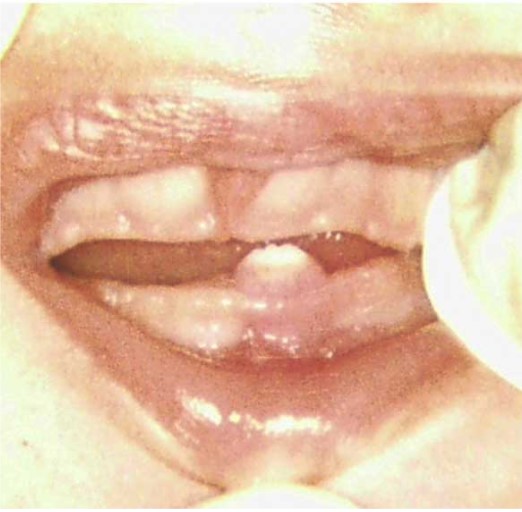Mother complained of breast soreness due to breastfeeding her 5-day-old baby girl who was born with a natal tooth.
Parents brought their 5-day-old baby girl to the paediatric dental clinic with concerns regarding a tooth in the lower jaw since birth. The mother complained of discomfort and soreness during breastfeeding her. Such a tooth, that is present at birth, is called natal tooth.
Medical history was unremarkable and there were no complications during the pregnancy either.
On physical examination, the baby had a symmetrical face without any deformity or lymphadenopathy. Examination of the oral cavity showed crown of a tooth in the anterior part of the lower jaw. The tooth was whitish opaque, small in size, and exhibiting grade II mobility. The rest of the examination was normal with clinically normal lips, gingivae palate, tongue, floor of the mouth, and buccal mucosa. The dentist did not observe any ulceration in the oral cavity of surface of the tongue.
The dentist diagnosed the baby with natal tooth. A periapical radiograph confirmed the diagnosis.
After educating, explaining, and discussing with the mother, they mutually decided in favour of extraction. Also, since the mother had complaints of soreness while breastfeeding extraction would be the most appropriate.
Prior to extraction, the dentist advised the mother to consult a paediatrician. The paediatrician recommended intramuscular vitamin K (0.5–1.0 mg) prior to the extraction to prevent potential haemorrhage.
The dentist extracted the natal tooth after topical anaesthesia followed by gentle curettage. The baby well tolerated the procedure. The extracted natal tooth did not have a root.
At the 5-day follow-up, the baby was doing well. The baby had no active complaints.
Natal Tooth:
The exact aetiology of natal teeth remains unknown. However, since the presence of a tooth at birth can be associated with developmental abnormalities and/or syndromes, it is imperative to perform a thorough physical examination to rule out any other associated condition.
A baby may have a conical natal tooth or the tooth may be of normal shape and size. However, usually, the crown of natal tooth is small.
Most commonly, natal teeth are present in the mandibular incisor region. It is more common in female babies as compared to males.
Management depends upon several factors including the mobility of the tooth. It is best to extract extremely mobile teeth to avoid the risk of aspiration. However, if the tooth is slightly mobile, it may stabilize soon after eruption. Besides the risk of aspiration, other complications include pain and soreness of the mother’s breasts during breastfeeding and ulceration/trauma to the tip of the baby’s tongue. The latter is seen in 6–10% of cases of natal teeth. Extraction has usually no complications, therefore, it is preferred.
Source:
Ghadah A. Malki, Emad A. Al-Badawi, Mohammad A. Dahlan, “Natal Teeth: A Case Report and Reappraisal”, Case Reports in Dentistry, vol. 2015, Article ID 147580, 4 pages, 2015. https://www.hindawi.com/journals/crid/2015/147580/




